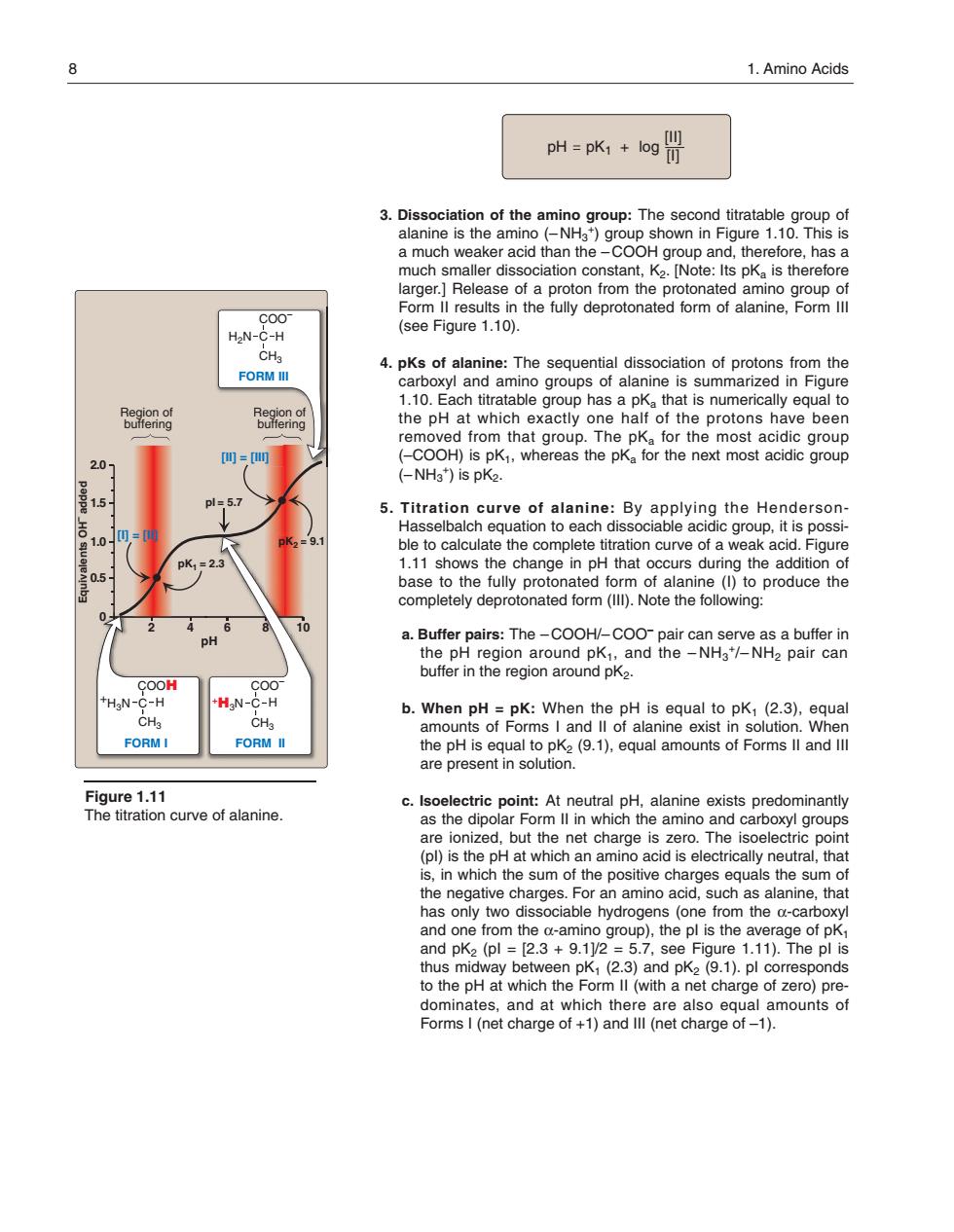正在加载图片...

1.Amino Acids H=K:+log 3 Dissociation of the amin up:The second titratable。 a much weaker acid than the-COOH group and,therefore,has a much taionocontant 2.[Note:Its spKa is therefore HA-O (see Figure 1.10). CHa th FORM III .Ke e:s and ocatonofpol 1.10.Each titratable group has a pK that is numerically equal to the pH at which exactly one half of the protons have beer he n group (-NHa")is pK2. 15 pl=5.7 up,it isp ble to calculate the complete titration curve of a weak acid.Figure =2 change in pH that occ urs aur gthe addition copleeyaepro8naiedioeaaNouehetb8 egion -COOH/-COO-pa around nk buffer in the region around pK2. +HgN-C b.When pH= (2. CH CH nd ll of a FORMI FORM II the pH is equal to pK2(9.1),equal amounts of Forms ll and Ill are present in solution. Figure1.11 c.Isoelectric po DH The titration curve of alanine. as the dipolar Form l in which the aming and carboxl are ionized,but the net charge is zero.The isoelectric point ne pH at whicn an amino acid is el has only two dissociable hydrogens(one from the a-carboxyl and one from the to the pH at which the Forml(with a net charge of zero)pre dominates,and at which there are also equal amounts of Forms I(net charge of+1)and Il (net charge of-1). 3. Dissociation of the amino group: The second titratable group of alanine is the amino (– NH3 +) group shown in Figure 1.10. This is a much weaker acid than the – COOH group and, therefore, has a much smaller dissociation constant, K2. [Note: Its pKa is therefore larger.] Release of a proton from the protonated amino group of Form II results in the fully deprotonated form of alanine, Form III (see Figure 1.10). 4. pKs of alanine: The sequential dissociation of protons from the carboxyl and amino groups of alanine is summarized in Figure 1.10. Each titratable group has a pKa that is numer ically equal to the pH at which exactly one half of the protons have been removed from that group. The pKa for the most acidic group (–COOH) is pK1, whereas the pKa for the next most acidic group (– NH3 +) is pK2. 5. Titration curve of alanine: By applying the Hender sonHasselbalch equation to each dissociable acidic group, it is possible to calculate the complete titration curve of a weak acid. Figure 1.11 shows the change in pH that occurs during the addition of base to the fully protonated form of alanine (I) to produce the completely deprotonated form (III). Note the following: a. Buffer pairs: The – COOH/– COO– pair can serve as a buffer in the pH region around pK1, and the – NH3 +/– NH2 pair can buffer in the region around pK2. b. When pH = pK: When the pH is equal to pK1 (2.3), equal amounts of Forms I and II of alanine exist in solution. When the pH is equal to pK2 (9.1), equal amounts of Forms II and III are present in solution. c. Isoelectric point: At neutral pH, alanine exists predominantly as the dipolar Form II in which the amino and carboxyl groups are ionized, but the net charge is zero. The isoelectric point (pI) is the pH at which an amino acid is electrically neutral, that is, in which the sum of the positive charges equals the sum of the negative charges. For an amino acid, such as alanine, that has only two dissociable hydrogens (one from the α-carboxyl and one from the α-amino group), the pI is the average of pK1 and pK2 (pI = [2.3 + 9.1]/2 = 5.7, see Figure 1.11). The pI is thus midway between pK1 (2.3) and pK2 (9.1). pI corresponds to the pH at which the Form II (with a net charge of zero) predominates, and at which there are also equal amounts of Forms I (net charge of +1) and III (net charge of –1). 8 1. Amino Acids Figure 1.11 The titration curve of alanine. 0 2 4 6 8 10 0 1.0 2.0 pH Equivalents OH– added pK2 = 9.1 [II] = [III] 0.5 1.5 pK1 = 2.3 [I] = [II] pI = 5.7 Region of buffering Region of buffering 0 2 4 0 p [II] = [III] Region of buffering 6 8 10 pH pK2 = 9. = 2.3 p COOH FORM I CH3 C +H3N H COO– FORM III CH3 H2N C H COO– FORM II CH3 C +H3N H pH pK1 log [II] [I] + 168397_P001-012.qxd7.0:02 Protein structure 5-20-04 2010.4.4 9:45 AM Page 8